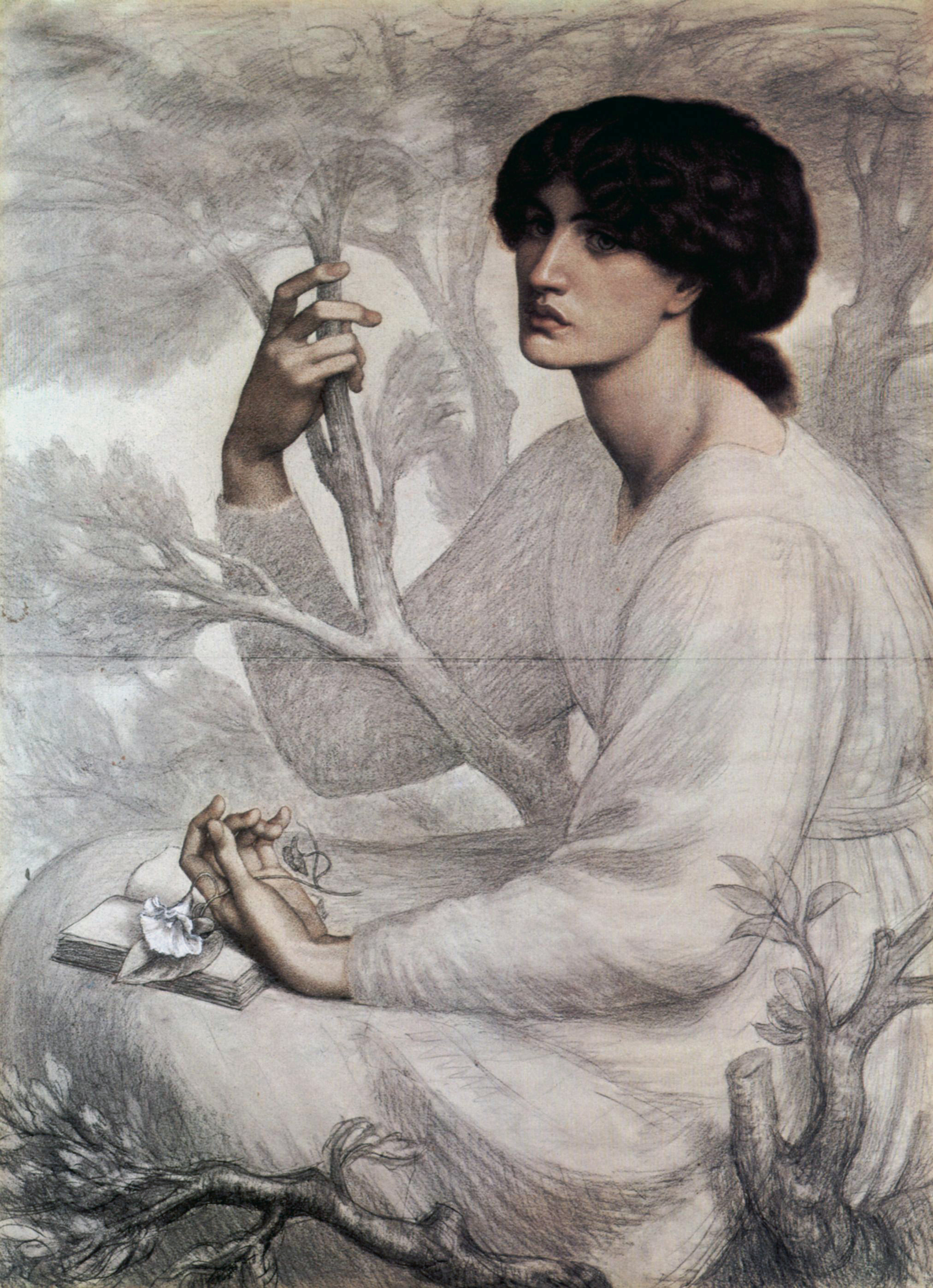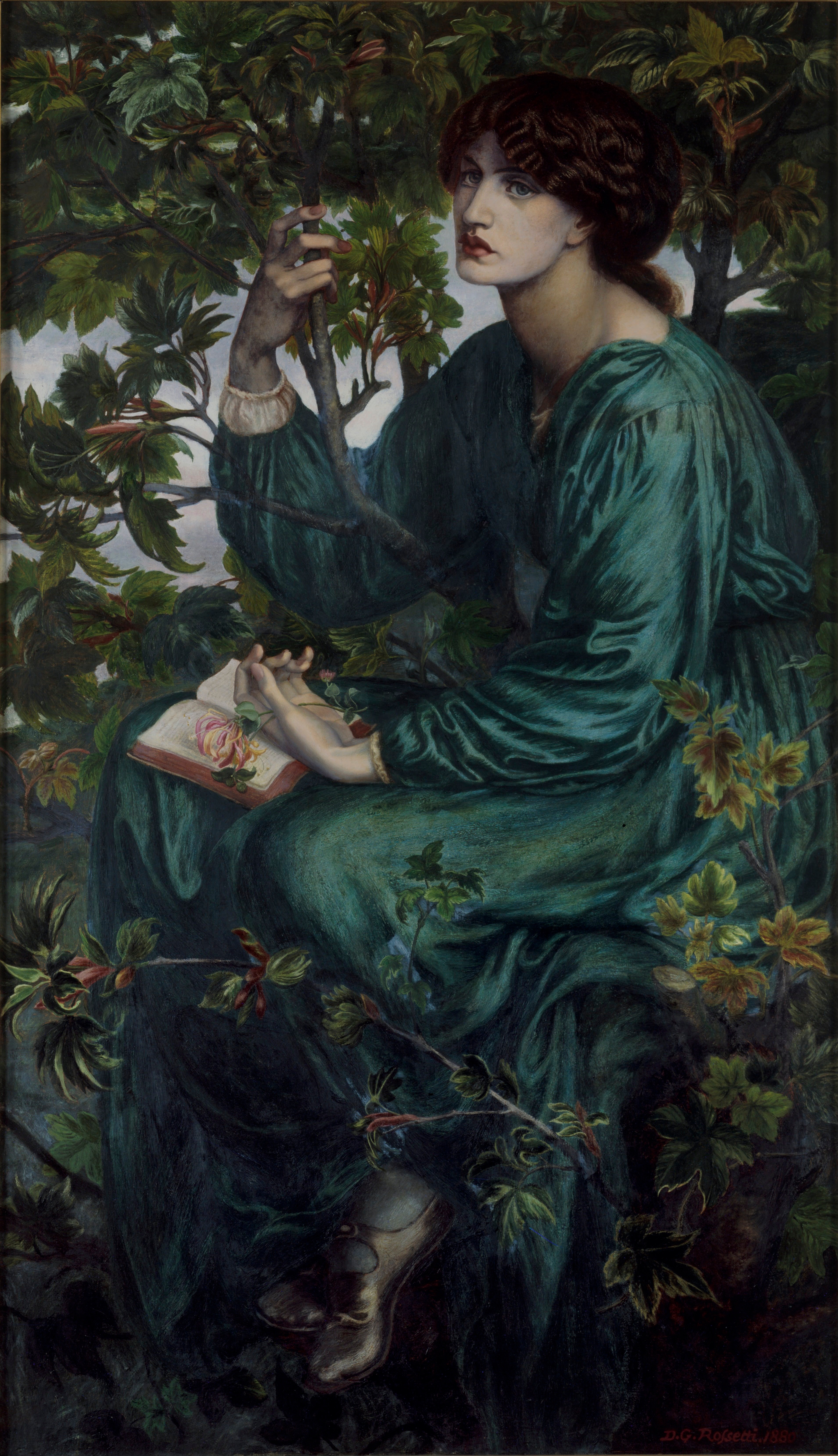The Day Dream, or as it was initially intended to be named, Monna Primavera, is an oil on canvas painting by the Pre-Raphaelite BrotherhoodGroup of English artists formed in 1848 to counter what they saw as the corrupting influence of the late-Renaissance painter Raphael. founder Dante Gabriel Rossetti. The work, which measures 158.7 centimetres (62.5 in) in height by 92.7 centimetres (36.5 in) wide, was undertaken in 1880 and depicts his lover Jane Morris sitting on the bough of a sycamore tree. A small stem of honeysuckle is in her hand, a token of love in the Victorian era, which may be a hint of their secret affair. The artwork was left to the Victoria and Albert Museum by Constantine Alexander Ionides in 1900.
Background
During 1878 Rossetti completed a chalk sketch of Jane Morris,[1] his secret lover, whom he had met at the Theatre Royal, Drury Lane in 1857. She was the model for several of his well-known paintings, including Proserpine.[2] The drawing was displayed above the mantlepiece in Rossetti’s studio.[3] Initially the painting was to be called Monna Primavera,[4] or Vanna Primavera, possibly inspired by La Vita Nuova,[5] a narrative that captivated Rossetti[6] and was the basis for earlier pieces of his works of art.[7]
Rossetti was also a poet, and wrote sonnets to accompany several of his paintings;[8] the last composition in his series, Sonnets for Pictures, is associated with this painting.[9] It reads:
Still bear young leaflets half the summer through;
From when the robin ‘gainst the unhidden blue
Perched dark, till now, deep in the leafy core,
The embowered throstle’s urgent wood-notes soar
Through summer silence. Still the leaves come new;
Yet never rosy-sheathed as those which drew
Their spiral tongues from spring-buds heretofore.
Within the branching shade of Reverie
Dreams even may spring till autumn; yet none be
Like woman’s budding day-dream spirit-fann’d.
Lo! tow’rd deep skies, not deeper than her look,
She dreams; till now on her forgotten book
Drops the forgotten blossom from her hand.[10]
Rossetti had not initially been fully satisfied with the painting, and made several revisions.[9] He wrote to Jane apologising for copying the feet of another woman to the picture.[11] An earlier painting of Jane, The Salutation of Beatrice, had similarly used a different model’s hands in the final version.[7]
Description

Wikimedia Commons
Jane is posed in seated position on the bough of a sycamore tree. A small stem of honeysuckle is in her hand, a token of love in the Victorian era, and perhaps an indication of the secret affair the artist was immersed in with her at the time.[12] Unusually for Rossetti’s work during this time – this is one of his last paintings – the model is portrayed full length;[13] it is signed “D. Rossetti 1880” on the lower right.[3]
The scene is a representation of a young woman in a green silk dress, shaded by the arabesque of the winged sycamore tree’s leaves. Above her head and around her the tree branches are depicted almost embracing her, or as if she was emerging from the tree itself, almost as a dryad, or tree nymph. She is portrayed clad all in green, her dress is a romantic wide and loose silk robe, flowing in graceful folds down, blending in with the tree’s leaves, that connects the subject and its surroundings visually. She is immersed in her day dreams, turning her gaze downwards, away, towards something unseen or perhaps only perceived by her. The depiction of the young, elegant woman in her shelter surrounded by the branches, is adding to the secretive feeling of the painting, maybe indicating the furtiveness of the affair or a clandestine meeting place. In the shelter it is dark, but around her shoulder there is light, light blue compartments against a dark-green background, signalling that it is daytime.
Exhibitions and provenance
The painting was left to the Victoria and Albert Museum by Constantine Alexander Ionides in 1900; he had commissioned Rossetti to undertake the work in 1879 for seven hundred guineas. Rossetti and Ionides corresponded throughout the duration of the work being undertaken on the painting; when it was almost completed on 18 March 1880 Rossetti wrote saying: “[it] will be beyond question as good a thing as I ever did.”[3] He also gave explicit instructions as to where the picture was to be positioned, including details as to the height from the floor and the direction from which the light should hit it.[3]

